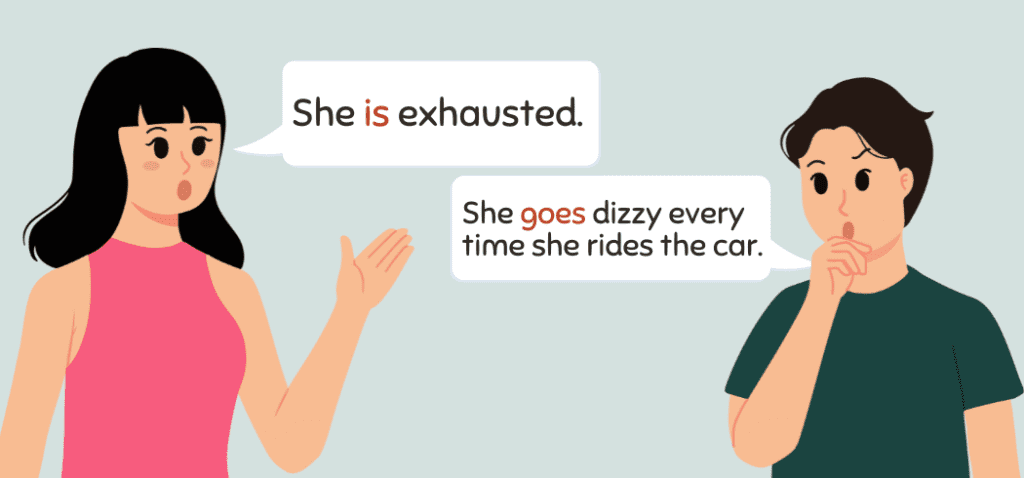
Candace Osmond studied Advanced Writing & Editing Essentials at MHC. She’s been an International and USA TODAY Bestselling Author for over a decade. And she’s worked as an Editor for several mid-sized publications. Candace has a keen eye for content editing and a high degree of expertise in Fiction.
Linking verbs do not have the same role as typical verbs that show action. The function of this verb type is to link a subject to its subject complement.
What is a linking verb? What are all the linking verbs? My handy dandy guide will show you the meaning, functions, and list of all linking verbs in the English language. Then, you can answer the worksheet I provided to check your understanding.

A linking verb does not show action like dynamic verbs. Instead, it is a type of verb that expresses a subject’s state of being. This function sets them apart from intransitive verbs, phrasal verbs, and impersonal verbs. For example:
In this sentence, feels establishes the state of being of the subject dress. It does not express the dress doing the act of feeling.
Some linking verb examples include is, feel, smell, and became. The most common linking verb is be in all its forms, such as is, was, am, and more. Here are more sentence examples.
Linking verbs are not part of action verb phrases. These sentence examples involve helping verbs instead of linking verbs.
We all know that sentences always contain subjects and predicates. Consider this example.
In this sentence, the subject is I, and the predicate is saw her on television. Saw is the action verb. It is an irregular verb which is the past verb form of see. Meanwhile, on television is a prepositional phrase.
Linking verbs are always a part of the predicate. But what makes them different from normal verbs is that they do not describe the action.
When a sentence has a linking verb instead of an action verb, it means they are not a monotransitive verb or a ditransitive verb, as there is no direct object. Instead, there is a subjective complement.
There are two types of subject complement after a linking verb that will determine the proper verb usage. These are also known as special predicates.
A linking verb is followed by a predicate noun or noun phrase when the word describing the object is a noun or noun phrase. For example:
In this sentence, the predicate nouns accountant and lawyer describe the subject I. They are linked by the linking verb became, which is in the past form.
A linking verb can link the subject to predicate adjectives when the word describing it includes adjectives or adjective phrases. For example:
In this sentence, the subject complement inefficient describes the subject solution.
Only the linking verb be can be described by an adverb, adverb phrase, or adverbial prepositional phrase of time or place. For example:
Upstairs may seem like an adjective, but it is an adverb indicating the phone’s location. It connects the predicate upstairs and the subject phone.
Here are more examples.
Here are some rules for using linking verbs.
You already know that the verb be can be followed by an adverb of time or phrase. But you should never use an adverb of manner to rename subjects. For example:
The first sentence is incorrect because adverbs modify verbs. Subject complements should rename and describe subjects. Therefore, it’s better to use an adjective that will describe Anthony, which is happy.
Because linking verbs have subject complements instead of direct objects, then they are categorized as intransitive verbs. For example:
As with other sentences, the subject should always agree with the verb. So when the subject is singular, the verb should be singular. But when the subject is plural, the verb should be plural.
Since predicate nominatives are in the subjective case, we often wonder which personal pronouns to use. The grammatically correct statement is “it is I” instead of “it is me” because I is the nominative form.
But you can also say “It was me” in less formal contexts. In fact, this sentence is more common.
All verbs, even linking verbs, show tense. For example, the simple present form of taste is taste/tastes. Its simple past form is tasted, and its simple future tense is will taste.
Remember that some linking verbs are irregular. For example, the simple present form of be is is or are, while its simple past form is was or were. However, the simple future tense of be is will be.

Let’s take a look at the definitions of the most common linking verbs.
The linking verb be means exist. For example:
The linking verb become means begin to be. For example:
Go has the same meaning as become. For example:
The linking verb keep means continue to be like this. But as an action verb, it has a common meaning of possession or ownership. For example:
Prove means to show a specific quality. But as an action verb, its meaning is to show with evidence. For example:
The linking verb fall talks about illness or silence. Here are some examples.
This list shows the English linking verbs. Remember that some of them can function as action and non-action verbs.
These lists of verbs are always linking verbs and can never be dynamic. That means they fall under the non-action verb category.
These linking verb phrases are different versions of be.
Notice how some of these linking verbs are also common action verbs and stative verbs.
There are 23 linking verbs in the English language. Eight of these linking verbs are always linking verbs and never expressing actions. Some examples include seem, be, and become in their different verb forms.
The most commonly used linking verbs in English are:
The word from is not a linking verb that expresses a state of being. Instead, it is a preposition.
There are many types of verbs in English. Linking verbs are not like other common verbs that express actions. Instead, they connect the subject with different types of predicates.
This guide has shown you the definition, functions, and examples of linking verbs. Expand your knowledge of the English language by learning more about verbs.

Grammarist is a participant in the Amazon Services LLC Associates Program, an affiliate advertising program designed to provide a means for sites to earn advertising fees by advertising and linking to Amazon.com. When you buy via the links on our site, we may earn an affiliate commission at no cost to you.